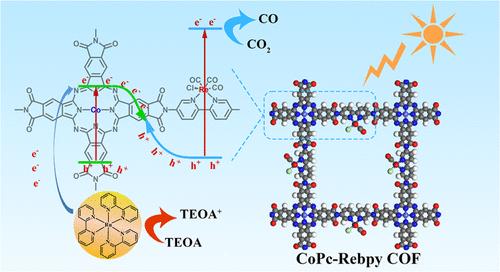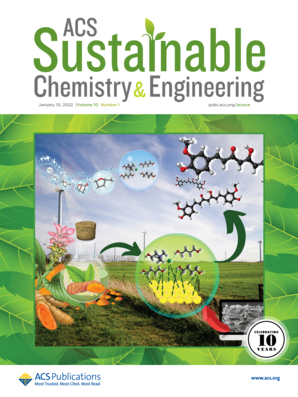Cobalt Phthalocyanine-Based Covalent Organic Framework with Bimetallic Synergistic Effect for Efficient Photocatalytic CO2 Reduction
IF 7.1
1区 化学
Q1 CHEMISTRY, MULTIDISCIPLINARY
引用次数: 0
Abstract
Covalent organic frameworks (COFs) have emerged as promising photocatalysts for the CO2 reduction reaction (CO2RR). Among various building components, metal phthalocyanines have gained significant attention owing to their excellent photochemical properties and well-defined M–N4 sites. Herein, tetraanhydrides of 2,3,9,10,16,17,23,24-octacarboxyphthalocyanine cobalt(II) (CoTAPc) are used as connection points to couple with bipyridine (bpy) for constructing an imine linked CoPc-bpy COF and then coordinated with Re(CO)3Cl to create a novel CoPc-Rebpy COF. It is found that there exists an intramolecular charge transfer from the CoPc to Rebpy units and then to Re center for CO2RR via Z-scheme molecular heterojunction mechanism. Under visible light illumination, the CoPc-bpy and CoPc-Rebpy COFs deliver CO yields of 3068 and 6680 μmol g–1 h–1, respectively. The significantly increased activity of CoPc-Rebpy COF can be ascribed to the synergistic effect of Re catalytic sites and the electron capture center provided by the CoPc unit. These findings present an effective strategy for COF-based photocatalysts for CO2RR.

具有双金属协同效应的酞菁钴基共价有机框架用于高效光催化还原二氧化碳
共价有机框架(COFs)已成为二氧化碳还原反应(CO2RR)中前景广阔的光催化剂。在各种构建成分中,金属酞菁因其出色的光化学特性和明确的 M-N4 位点而备受关注。在本文中,2,3,9,10,16,17,23,24-八羧基酞菁钴(II)(CoTAPc)的四酸酐被用作连接点,与双吡啶(bpy)耦合以构建亚胺连接的 CoPc-bpy COF,然后与 Re(CO)3Cl 配位以创建新型 CoPc-Rebpy COF。研究发现,CoPc 与 Rebpy 单元之间存在分子内电荷转移,然后通过 Z 型分子异质结机制将电荷转移到 Re 中心,实现 CO2RR。在可见光照射下,CoPc-bpy 和 CoPc-Rebpy COFs 的 CO 产率分别为 3068 和 6680 μmol g-1 h-1。CoPc-Rebpy COF 活性的大幅提高可归因于 Re 催化位点和 CoPc 单元提供的电子捕获中心的协同效应。这些发现为基于 COF 的 CO2RR 光催化剂提供了一种有效的策略。
本文章由计算机程序翻译,如有差异,请以英文原文为准。
求助全文
约1分钟内获得全文
求助全文
来源期刊

ACS Sustainable Chemistry & Engineering
CHEMISTRY, MULTIDISCIPLINARY-ENGINEERING, CHEMICAL
CiteScore
13.80
自引率
4.80%
发文量
1470
审稿时长
1.7 months
期刊介绍:
ACS Sustainable Chemistry & Engineering is a prestigious weekly peer-reviewed scientific journal published by the American Chemical Society. Dedicated to advancing the principles of green chemistry and green engineering, it covers a wide array of research topics including green chemistry, green engineering, biomass, alternative energy, and life cycle assessment.
The journal welcomes submissions in various formats, including Letters, Articles, Features, and Perspectives (Reviews), that address the challenges of sustainability in the chemical enterprise and contribute to the advancement of sustainable practices. Join us in shaping the future of sustainable chemistry and engineering.
 求助内容:
求助内容: 应助结果提醒方式:
应助结果提醒方式:


